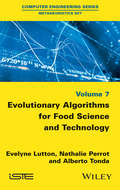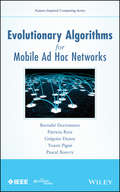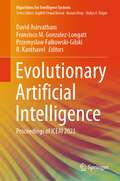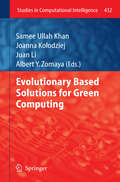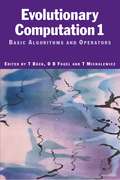- Table View
- List View
Evolutionary Algorithms for Food Science and Technology
by Evelyne Lutton Nathalie Perrot Alberto TondaResearchers and practitioners in food science and technology routinely face several challenges, related to sparseness and heterogeneity of data, as well as to the uncertainty in the measurements and the introduction of expert knowledge in the models. Evolutionary algorithms (EAs), stochastic optimization techniques loosely inspired by natural selection, can be effectively used to tackle these issues. In this book, we present a selection of case studies where EAs are adopted in real-world food applications, ranging from model learning to sensitivity analysis.
Evolutionary Algorithms for Food Science and Technology
by Evelyne Lutton Nathalie Perrot Alberto TondaResearchers and practitioners in food science and technology routinely face several challenges, related to sparseness and heterogeneity of data, as well as to the uncertainty in the measurements and the introduction of expert knowledge in the models. Evolutionary algorithms (EAs), stochastic optimization techniques loosely inspired by natural selection, can be effectively used to tackle these issues. In this book, we present a selection of case studies where EAs are adopted in real-world food applications, ranging from model learning to sensitivity analysis.
Evolutionary Algorithms for Mobile Ad Hoc Networks (Nature-Inspired Computing Series)
by Bernabé Dorronsoro Patricia Ruiz Grégoire Danoy Yoann Pigné Pascal BouvryDescribes how evolutionary algorithms (EAs) can be used to identify, model, and minimize day-to-day problems that arise for researchers in optimization and mobile networking Mobile ad hoc networks (MANETs), vehicular networks (VANETs), sensor networks (SNs), and hybrid networks—each of these require a designer’s keen sense and knowledge of evolutionary algorithms in order to help with the common issues that plague professionals involved in optimization and mobile networking. This book introduces readers to both mobile ad hoc networks and evolutionary algorithms, presenting basic concepts as well as detailed descriptions of each. It demonstrates how metaheuristics and evolutionary algorithms (EAs) can be used to help provide low-cost operations in the optimization process—allowing designers to put some “intelligence” or sophistication into the design. It also offers efficient and accurate information on dissemination algorithms, topology management, and mobility models to address challenges in the field. Evolutionary Algorithms for Mobile Ad Hoc Networks: Instructs on how to identify, model, and optimize solutions to problems that arise in daily research Presents complete and up-to-date surveys on topics like network and mobility simulators Provides sample problems along with solutions/descriptions used to solve each, with performance comparisons Covers current, relevant issues in mobile networks, like energy use, broadcasting performance, device mobility, and more Evolutionary Algorithms for Mobile Ad Hoc Networks is an ideal book for researchers and students involved in mobile networks, optimization, advanced search techniques, and multi-objective optimization.
Evolutionary Algorithms for Mobile Ad Hoc Networks (Nature-Inspired Computing Series)
by Bernabé Dorronsoro Patricia Ruiz Grégoire Danoy Yoann Pigné Pascal BouvryDescribes how evolutionary algorithms (EAs) can be used to identify, model, and minimize day-to-day problems that arise for researchers in optimization and mobile networking Mobile ad hoc networks (MANETs), vehicular networks (VANETs), sensor networks (SNs), and hybrid networks—each of these require a designer’s keen sense and knowledge of evolutionary algorithms in order to help with the common issues that plague professionals involved in optimization and mobile networking. This book introduces readers to both mobile ad hoc networks and evolutionary algorithms, presenting basic concepts as well as detailed descriptions of each. It demonstrates how metaheuristics and evolutionary algorithms (EAs) can be used to help provide low-cost operations in the optimization process—allowing designers to put some “intelligence” or sophistication into the design. It also offers efficient and accurate information on dissemination algorithms, topology management, and mobility models to address challenges in the field. Evolutionary Algorithms for Mobile Ad Hoc Networks: Instructs on how to identify, model, and optimize solutions to problems that arise in daily research Presents complete and up-to-date surveys on topics like network and mobility simulators Provides sample problems along with solutions/descriptions used to solve each, with performance comparisons Covers current, relevant issues in mobile networks, like energy use, broadcasting performance, device mobility, and more Evolutionary Algorithms for Mobile Ad Hoc Networks is an ideal book for researchers and students involved in mobile networks, optimization, advanced search techniques, and multi-objective optimization.
Evolutionary Algorithms for Solving Multi-Objective Problems (Genetic and Evolutionary Computation)
by Carlos Coello Coello Gary B. Lamont David A. van VeldhuizenThis textbook is a second edition of Evolutionary Algorithms for Solving Multi-Objective Problems, significantly expanded and adapted for the classroom. The various features of multi-objective evolutionary algorithms are presented here in an innovative and student-friendly fashion, incorporating state-of-the-art research. The book disseminates the application of evolutionary algorithm techniques to a variety of practical problems. It contains exhaustive appendices, index and bibliography and links to a complete set of teaching tutorials, exercises and solutions.
Evolutionary Algorithms for Solving Multi-Objective Problems (Genetic Algorithms and Evolutionary Computation #5)
by Carlos Coello Coello David A. Van Veldhuizen Gary B. LamontResearchers and practitioners alike are increasingly turning to search, op timization, and machine-learning procedures based on natural selection and natural genetics to solve problems across the spectrum of human endeavor. These genetic algorithms and techniques of evolutionary computation are solv ing problems and inventing new hardware and software that rival human designs. The Kluwer Series on Genetic Algorithms and Evolutionary Computation pub lishes research monographs, edited collections, and graduate-level texts in this rapidly growing field. Primary areas of coverage include the theory, implemen tation, and application of genetic algorithms (GAs), evolution strategies (ESs), evolutionary programming (EP), learning classifier systems (LCSs) and other variants of genetic and evolutionary computation (GEC). The series also pub lishes texts in related fields such as artificial life, adaptive behavior, artificial immune systems, agent-based systems, neural computing, fuzzy systems, and quantum computing as long as GEC techniques are part of or inspiration for the system being described. This encyclopedic volume on the use of the algorithms of genetic and evolu tionary computation for the solution of multi-objective problems is a landmark addition to the literature that comes just in the nick of time. Multi-objective evolutionary algorithms (MOEAs) are receiving increasing and unprecedented attention. Researchers and practitioners are finding an irresistible match be tween the popUlation available in most genetic and evolutionary algorithms and the need in multi-objective problems to approximate the Pareto trade-off curve or surface.
Evolutionary Algorithms for VLSI CAD
by Rolf DrechslerIn VLSI CAD, difficult optimization problems have to be solved on a constant basis. Various optimization techniques have been proposed in the past. While some of these methods have been shown to work well in applications and have become somewhat established over the years, other techniques have been ignored. Recently, there has been a growing interest in optimization algorithms based on principles observed in nature, termed Evolutionary Algorithms (EAs). Evolutionary Algorithms in VLSI CAD presents the basic concepts of EAs, and considers the application of EAs in VLSI CAD. It is the first book to show how EAs could be used to improve IC design tools and processes. Several successful applications from different areas of circuit design, like logic synthesis, mapping and testing, are described in detail. Evolutionary Algorithms in VLSI CAD consists of two parts. The first part discusses basic principles of EAs and provides some easy-to-understand examples. Furthermore, a theoretical model for multi-objective optimization is presented. In the second part a software implementation of EAs is supplied together with detailed descriptions of several EA applications. These applications cover a wide range of VLSI CAD, and different methods for using EAs are described. Evolutionary Algorithms in VLSI CAD is intended for CAD developers and researchers as well as those working in evolutionary algorithms and techniques supporting modern design tools and processes.
Evolutionary Algorithms in Engineering Applications
by Dipankar Dasgupta Zbigniew MichalewiczEvolutionary algorithms are general-purpose search procedures based on the mechanisms of natural selection and population genetics. They are appealing because they are simple, easy to interface, and easy to extend. This volume is concerned with applications of evolutionary algorithms and associated strategies in engineering. It will be useful for engineers, designers, developers, and researchers in any scientific discipline interested in the applications of evolutionary algorithms. The volume consists of five parts, each with four or five chapters. The topics are chosen to emphasize application areas in different fields of engineering. Each chapter can be used for self-study or as a reference by practitioners to help them apply evolutionary algorithms to problems in their engineering domains.
Evolutionary Algorithms in Management Applications
by Jörg Biethahn Volker NissenEvolutionary Algorithms (EA) are powerful search and optimisation techniques inspired by the mechanisms of natural evolution. They imitate, on an abstract level, biological principles such as a population based approach, the inheritance of information, the variation of information via crossover/mutation, and the selection of individuals based on fitness. The most well-known class of EA are Genetic Algorithms (GA), which have received much attention not only in the scientific community lately. Other variants of EA, in particular Genetic Programming, Evolution Strategies, and Evolutionary Programming are less popular, though very powerful too. Traditionally, most practical applications of EA have appeared in the technical sector. Management problems, for a long time, have been a rather neglected field of EA-research. This is surprising, since the great potential of evolutionary approaches for the business and economics domain was recognised in pioneering publications quite a while ago. John Holland, for instance, in his seminal book Adaptation in Natural and Artificial Systems (The University of Michigan Press, 1975) identified economics as one of the prime targets for a theory of adaptation, as formalised in his reproductive plans (later called Genetic Algorithms).
Evolutionary Algorithms in Theory and Practice: Evolution Strategies, Evolutionary Programming, Genetic Algorithms
by Thomas BackThis book presents a unified view of evolutionary algorithms: the exciting new probabilistic search tools inspired by biological models that have immense potential as practical problem-solvers in a wide variety of settings, academic, commercial, and industrial. In this work, the author compares the three most prominent representatives of evolutionary algorithms: genetic algorithms, evolution strategies, and evolutionary programming. The algorithms are presented within a unified framework, thereby clarifying the similarities and differences of these methods. The author also presents new results regarding the role of mutation and selection in genetic algorithms, showing how mutation seems to be much more important for the performance of genetic algorithms than usually assumed. The interaction of selection and mutation, and the impact of the binary code are further topics of interest. Some of the theoretical results are also confirmed by performing an experiment in meta-evolution on a parallel computer. The meta-algorithm used in this experiment combines components from evolution strategies and genetic algorithms to yield a hybrid capable of handling mixed integer optimization problems. As a detailed description of the algorithms, with practical guidelines for usage and implementation, this work will interest a wide range of researchers in computer science and engineering disciplines, as well as graduate students in these fields.
Evolutionary and Adaptive Computing in Engineering Design
by Ian C. ParmeeFollowing an introduction to the various techniques and examples of their routine application, this potential is explored through the introduction of various strategies that support searches across a far broader set of possible design solutions within time and budget constraints. Generic problem areas investigated include: - design decomposition; - whole-system design; - multi-objective and constraint satisfaction; - human-computer interaction; - computational expense. Appropriate strategies that help overcome problems often encountered when integrating computer-based techniques with complex, real-world design environments are described. A straightforward approach coupled with examples supports a rapid understanding of the manner in which such strategies can best be designed to handle the complexities of a particular problem.
Evolutionary and Biologically Inspired Music, Sound, Art and Design: 4th International Conference, EvoMUSART 2015, Copenhagen, Denmark, April 8-10, 2015, Proceedings (Lecture Notes in Computer Science #9027)
by Colin Johnson Adrian Carballal João CorreiaThis book constitutes the refereed proceedings of the 4th International Conference on Biologically Inspired Music, Sound, Art and Design, EvoMUSART 2015, held in Copenhagen, Denmark, in April 2015, co-located with the Evo* 2015 events EuroGP, EvoCOP and Evo Applications. The 23 revised full papers presented were carefully reviewed and selected from 43 submissions. They cover a wide range of topics and application areas, including generative approaches to music, graphics, game content and narrative; music information retrieval; computational aesthetics; the mechanics of interactive evolutionary computation and the art theory of evolutionary computation.
Evolutionary and Biologically Inspired Music, Sound, Art and Design: 5th International Conference, EvoMUSART 2016, Porto, Portugal, March 30 -- April 1, 2016, Proceedings (Lecture Notes in Computer Science #9596)
by Colin Johnson Vic Ciesielski João Correia Penousal MachadoThis book constitutes the refereed proceedings of the 5th International Conference on Evolutionary and Biologically Inspired Music, Sound, Art and Design, EvoMUSART 2016, held in Porto, Portugal, in March/April 2016, co-located with the Evo*2016 events EuroGP, EvoCOP and EvoApplications. The 17 revised full papers presented were carefully reviewed and selected from 25 submissions. The papers cover a wide range of topics and application areas, including generative approaches to music, graphics, game content, and narrative; music information retrieval; computational aesthetics; the mechanics of interactive evolutionary computation; and the art theory of evolutionary computation.
Evolutionary and Biologically Inspired Music, Sound, Art and Design: Second International Conference, EvoMUSART 2013, Vienna, Austria, April 3-5, 2013, Proceedings (Lecture Notes in Computer Science #7834)
by Penousal Machado James McDermott Adrian CarballalThis book constitutes the refereed proceedings of the Second International Conference on Biologically Inspired Music, Sound, Art and Design, EvoMUSART 2013, held in Vienna, Austria, in March 2013, colocated with the Evo* 2013 events EuroGP, EvoCOP, EvoBIO, and EvoApplications. The 11 revised full papers and 5 poster papers presented were carefully reviewed and selected from 36 submissions. They cover a wide range of topics and application areas, including: generative approaches to music, graphics, game content, and narrative; robot gait creation; music information retrieval; computational aesthetics; the mechanics of interactive evolutionary computation; and the art theory of evolutionary computation.
Evolutionary and Biologically Inspired Music, Sound, Art and Design: First International Conference, EvoMUSART 2012, Málaga, Spain, April 11-13, 2012, Proceedings (Lecture Notes in Computer Science #7247)
by Penousal Machado Juan J. Romero Adrian CarballalThis book constitutes the refereed proceedings of the First International Conference on Biologically Inspired Music, Sound, Art and Design, EvoMUSART 2012, held in Málaga, Spain, in April 2012, colocated with the Evo* 2012 events EuroGP, EvoCOP, EvoBIO, and EvoApplications. Due to its significant growth in the last 10 years, this 10th EvoMUSART event has become an Evo* conference in 2012. The 15 revised full papers and 5 poster papers presented were carefully reviewed and selected from 43 submissions. They cover a wide range of topics reflecting the current state of research in the field, including theory, generation, computer aided creativity, computational creativity, and automation.
Evolutionary and Biologically Inspired Music, Sound, Art and Design: Third European Conference, EvoMUSART 2014, Granada, Spain, April 23-25, 2014, Revised Selected Papers (Lecture Notes in Computer Science #8601)
by Juan Romero James McDermott Joao CorreiaThis book constitutes the refereed proceedings of the Third International Conference on Biologically Inspired Music, Sound, Art and Design, Evo MUSART 2014, held in Granada, Spain, in April 2014, co-located with the Evo* 2013 events Euro GP, Evo COP, Evo BIO and Evo Applications.The 11 revised full papers presented were carefully reviewed and selected from 30 submissions. They cover a wide range of topics and application areas.
Evolutionary and Memetic Computing for Project Portfolio Selection and Scheduling (Adaptation, Learning, and Optimization #26)
by Kyle Robert Harrison Saber Elsayed Ivan Leonidovich Garanovich Terence Weir Sharon G. Boswell Ruhul Amin SarkerThis book consists of eight chapters, authored by distinguished researchers and practitioners, that highlight the state of the art and recent trends in addressing the project portfolio selection and scheduling problem (PPSSP) across a variety of domains, particularly defense, social programs, supply chains, and finance. Many organizations face the challenge of selecting and scheduling a subset of available projects subject to various resource and operational constraints. In the simplest scenario, the primary objective for an organization is to maximize the value added through funding and implementing a portfolio of projects, subject to the available budget. However, there are other major difficulties that are often associated with this problem such as qualitative project benefits, multiple conflicting objectives, complex project interdependencies, workforce and manufacturing constraints, and deep uncertainty regarding project costs, benefits, and completion times.It is well known that the PPSSP is an NP-hard problem and, thus, there is no known polynomial-time algorithm for this problem. Despite the complexity associated with solving the PPSSP, many traditional approaches to this problem make use of exact solvers. While exact solvers provide definitive optimal solutions, they quickly become prohibitively expensive in terms of computation time when the problem size is increased. In contrast, evolutionary and memetic computing afford the capability for autonomous heuristic approaches and expert knowledge to be combined and thereby provide an efficient means for high-quality approximation solutions to be attained. As such, these approaches can provide near real-time decision support information for portfolio design that can be used to augment and improve existing human-centric strategic decision-making processes. This edited book provides the reader with a broad overview of the PPSSP, its associated challenges, and approaches to addressing the problem using evolutionary and memetic computing.
Evolutionary and Swarm Intelligence Algorithms (Studies in Computational Intelligence #779)
by Jagdish Chand Bansal Pramod Kumar Singh Nikhil R. PalThis book is a delight for academics, researchers and professionals working in evolutionary and swarm computing, computational intelligence, machine learning and engineering design, as well as search and optimization in general. It provides an introduction to the design and development of a number of popular and recent swarm and evolutionary algorithms with a focus on their applications in engineering problems in diverse domains. The topics discussed include particle swarm optimization, the artificial bee colony algorithm, Spider Monkey optimization algorithm, genetic algorithms, constrained multi-objective evolutionary algorithms, genetic programming, and evolutionary fuzzy systems. A friendly and informative treatment of the topics makes this book an ideal reference for beginners and those with experience alike.
Evolutionary Approach to Machine Learning and Deep Neural Networks: Neuro-Evolution and Gene Regulatory Networks
by Hitoshi IbaThis book provides theoretical and practical knowledge about a methodology for evolutionary algorithm-based search strategy with the integration of several machine learning and deep learning techniques. These include convolutional neural networks, Gröbner bases, relevance vector machines, transfer learning, bagging and boosting methods, clustering techniques (affinity propagation), and belief networks, among others. The development of such tools contributes to better optimizing methodologies. Beginning with the essentials of evolutionary algorithms and covering interdisciplinary research topics, the contents of this book are valuable for different classes of readers: novice, intermediate, and also expert readers from related fields.Following the chapters on introduction and basic methods, Chapter 3 details a new research direction, i.e., neuro-evolution, an evolutionary method for the generation of deep neural networks, and also describes how evolutionary methods are extended in combination with machine learning techniques. Chapter 4 includes novel methods such as particle swarm optimization based on affinity propagation (PSOAP), and transfer learning for differential evolution (TRADE), another machine learning approach for extending differential evolution. The last chapter is dedicated to the state of the art in gene regulatory network (GRN) research as one of the most interesting and active research fields. The author describes an evolving reaction network, which expands the neuro-evolution methodology to produce a type of genetic network suitable for biochemical systems and has succeeded in designing genetic circuits in synthetic biology. The author also presents real-world GRN application to several artificial intelligent tasks, proposing a framework of motion generation by GRNs (MONGERN), which evolves GRNs to operate a real humanoid robot.
Evolutionary Artificial Intelligence: Proceedings of ICEAI 2023 (Algorithms for Intelligent Systems)
by David Asirvatham Francisco M. Gonzalez-Longatt Przemyslaw Falkowski-Gilski R. KanthavelThis book gathers a collection of selected works and new research results of scholars and graduate students presented at International Conference on Evolutionary Artificial Intelligence (ICEAI 2023) held in Malaysia during 13-14 September 2023. The focus of the book is interdisciplinary in nature and includes research on all aspects of evolutionary computation to find effective solutions to a wide range of computationally difficult problems. The book covers topics such as particle swarm optimization, evolutionary programming, genetic programming, hybrid evolutionary algorithms, ant colony optimization, evolutionary neural networks, evolutionary reinforcement learning, genetic algorithms, memetic algorithms, novel bio-inspired algorithms, evolving multi-agent systems, agent-based evolutionary approaches, and evolutionary game theory.
Evolutionary Based Solutions for Green Computing (Studies in Computational Intelligence #432)
by Albert Y. Zomaya Samee Ullah Khan Joanna Ko 322 Odziej Juan LiToday’s highly parameterized large-scale distributed computing systems may be composed of a large number of various components (computers, databases, etc) and must provide a wide range of services. The users of such systems, located at different (geographical or managerial) network cluster may have a limited access to the system’s services and resources, and different, often conflicting, expectations and requirements. Moreover, the information and data processed in such dynamic environments may be incomplete, imprecise, fragmentary, and overloading. All of the above mentioned issues require some intelligent scalable methodologies for the management of the whole complex structure, which unfortunately may increase the energy consumption of such systems. An optimal energy utilization has reached to a point that many information technology (IT) managers and corporate executives are all up in arms to identify scalable solution that can reduce electricity consumption (so that the total cost of operation is minimized) of their respective large-scale computing systems and simultaneously improve upon or maintain the current throughput of the system. This book in its eight chapters, addresses the fundamental issues related to the energy usage and the optimal low-cost system design in high performance ``green computing’’ systems. The recent evolutionary and general metaheuristic-based solutions for energy optimization in data processing, scheduling, resource allocation, and communication in modern computational grids, could and network computing are presented along with several important conventional technologies to cover the hot topics from the fundamental theory of the ‘’green computing’’ concept and to describe the basic architectures of systems. This book points out the potential application areas and provides detailed examples of application case studies in low-energy computational systems. The development trends and open research issues are also outlined. All of those technologies have formed the foundation for the green computing that we know of today.
Evolutionary Biology: Concept, Modeling, and Application
by Pierre PontarottiSince 1997, scientists of different disciplines sharing a deep interest in concepts and knowledge related to evolutionary biology have held the annual Evolutionary Biology Meetings in Marseille in order to discuss their research and promote collaboration. Lately scientists especially focusing on applications have also joined the group. This book starts with the report of the "12th Evolutionary Biology Meeting", which gives a general idea of the meeting’s epistemological stance. This is followed by 22 chapters, a selection of the most representative contributions, which are grouped under the following four themes: Part I Concepts and Knowledge - Part II Modelization - Part III Applied Evolutionary Biology - Part IV Applications in Other Fields -Part IV transcends the field of biology, presenting applications of evolutionary biology in economics and astronomy.
Evolutionary Computation: Techniques and Applications
by Ashish M. Gujarathi B. V. BabuEdited by professionals with years of experience, this book provides an introduction to the theory of evolutionary algorithms and single- and multi-objective optimization, and then goes on to discuss to explore applications of evolutionary algorithms for many uses with real-world applications. Covering both the theory and applications of evolutionary computation, the book offers exhaustive coverage of several topics on nontraditional evolutionary techniques, details working principles of new and popular evolutionary algorithms, and discusses case studies on both scientific and real-world applications of optimization
Evolutionary Computation: Techniques and Applications
by Ashish M. Gujrathi B. V. BabuEdited by professionals with years of experience, this book provides an introduction to the theory of evolutionary algorithms and single- and multi-objective optimization, and then goes on to discuss to explore applications of evolutionary algorithms for many uses with real-world applications. Covering both the theory and applications of evolutionary computation, the book offers exhaustive coverage of several topics on nontraditional evolutionary techniques, details working principles of new and popular evolutionary algorithms, and discusses case studies on both scientific and real-world applications of optimization
Evolutionary Computation 1: Basic Algorithms and Operators (Ieee Press Series On Computational Intelligence Ser. #1)
by Thomas Bäck David B Fogel Zbigniew MichalewiczThe field of evolutionary computation is expanding dramatically, fueled by the vast investment that reflects the value of applying its techniques. Culling material from the Handbook of Evolutionary Computation, Evolutionary Computation 1: Basic Algorithms and Operators contains up-to-date information on algorithms and operators used in evolutionary computing. This volume discusses the basic ideas that underlie the main paradigms of evolutionary algorithms, evolution strategies, evolutionary programming, and genetic programming. It is intended to be used by individual researchers, teachers, and students working and studying in this expanding field.
